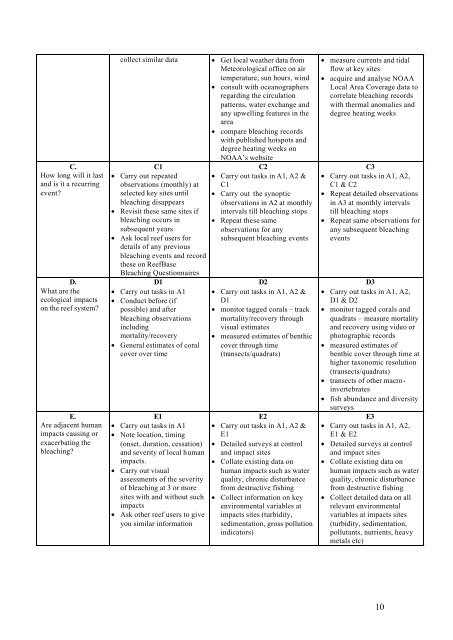Oliver et al (2004) Monitoring bleaching
Oliver et al (2004) Monitoring bleaching.pdf
Oliver et al (2004) Monitoring bleaching.pdf
Create successful ePaper yourself
Turn your PDF publications into a flip-book with our unique Google optimized e-Paper software.
C.<br />
How long will it last<br />
and is it a recurring<br />
event?<br />
D.<br />
What are the<br />
ecologic<strong>al</strong> impacts<br />
on the reef system?<br />
E.<br />
Are adjacent human<br />
impacts causing or<br />
exacerbating the<br />
<strong>bleaching</strong>?<br />
collect similar data<br />
C1<br />
• Carry out repeated<br />
observations (monthly) at<br />
selected key sites until<br />
<strong>bleaching</strong> disappears<br />
• Revisit these same sites if<br />
<strong>bleaching</strong> occurs in<br />
subsequent years<br />
• Ask loc<strong>al</strong> reef users for<br />
d<strong>et</strong>ails of any previous<br />
<strong>bleaching</strong> events and record<br />
these on ReefBase<br />
Bleaching Questionnaires<br />
D1<br />
• Carry out tasks in A1<br />
• Conduct before (if<br />
possible) and after<br />
<strong>bleaching</strong> observations<br />
including<br />
mort<strong>al</strong>ity/recovery<br />
• Gener<strong>al</strong> estimates of cor<strong>al</strong><br />
cover over time<br />
E1<br />
• Carry out tasks in A1<br />
• Note location, timing<br />
(ons<strong>et</strong>, duration, cessation)<br />
and severity of loc<strong>al</strong> human<br />
impacts.<br />
• Carry out visu<strong>al</strong><br />
assessments of the severity<br />
of <strong>bleaching</strong> at 3 or more<br />
sites with and without such<br />
impacts<br />
• Ask other reef users to give<br />
you similar information<br />
• G<strong>et</strong> loc<strong>al</strong> weather data from<br />
M<strong>et</strong>eorologic<strong>al</strong> office on air<br />
temperature, sun hours, wind<br />
• consult with oceanographers<br />
regarding the circulation<br />
patterns, water exchange and<br />
any upwelling features in the<br />
area<br />
• compare <strong>bleaching</strong> records<br />
with published hotspots and<br />
degree heating weeks on<br />
NOAA’s website<br />
C2<br />
• Carry out tasks in A1, A2 &<br />
C1<br />
• Carry out the synoptic<br />
observations in A2 at monthly<br />
interv<strong>al</strong>s till <strong>bleaching</strong> stops<br />
• Repeat these same<br />
observations for any<br />
subsequent <strong>bleaching</strong> events<br />
D2<br />
• Carry out tasks in A1, A2 &<br />
D1<br />
• monitor tagged cor<strong>al</strong>s – track<br />
mort<strong>al</strong>ity/recovery through<br />
visu<strong>al</strong> estimates<br />
• measured estimates of benthic<br />
cover through time<br />
(transects/quadrats)<br />
E2<br />
• Carry out tasks in A1, A2 &<br />
E1<br />
• D<strong>et</strong>ailed surveys at control<br />
and impact sites<br />
• Collate existing data on<br />
human impacts such as water<br />
qu<strong>al</strong>ity, chronic disturbance<br />
from destructive fishing<br />
• Collect information on key<br />
environment<strong>al</strong> variables at<br />
impacts sites (turbidity,<br />
sedimentation, gross pollution<br />
indicators)<br />
• measure currents and tid<strong>al</strong><br />
flow at key sites<br />
• acquire and an<strong>al</strong>yse NOAA<br />
Loc<strong>al</strong> Area Coverage data to<br />
correlate <strong>bleaching</strong> records<br />
with therm<strong>al</strong> anom<strong>al</strong>ies and<br />
degree heating weeks<br />
C3<br />
• Carry out tasks in A1, A2,<br />
C1 & C2<br />
• Repeat d<strong>et</strong>ailed observations<br />
in A3 at monthly interv<strong>al</strong>s<br />
till <strong>bleaching</strong> stops<br />
• Repeat same observations for<br />
any subsequent <strong>bleaching</strong><br />
events<br />
D3<br />
• Carry out tasks in A1, A2,<br />
D1 & D2<br />
• monitor tagged cor<strong>al</strong>s and<br />
quadrats – measure mort<strong>al</strong>ity<br />
and recovery using video or<br />
photographic records<br />
• measured estimates of<br />
benthic cover through time at<br />
higher taxonomic resolution<br />
(transects/quadrats)<br />
• transects of other macroinvertebrates<br />
• fish abundance and diversity<br />
surveys<br />
E3<br />
• Carry out tasks in A1, A2,<br />
E1 & E2<br />
• D<strong>et</strong>ailed surveys at control<br />
and impact sites<br />
• Collate existing data on<br />
human impacts such as water<br />
qu<strong>al</strong>ity, chronic disturbance<br />
from destructive fishing<br />
• Collect d<strong>et</strong>ailed data on <strong>al</strong>l<br />
relevant environment<strong>al</strong><br />
variables at impacts sites<br />
(turbidity, sedimentation,<br />
pollutants, nutrients, heavy<br />
m<strong>et</strong><strong>al</strong>s <strong>et</strong>c)<br />
10


















